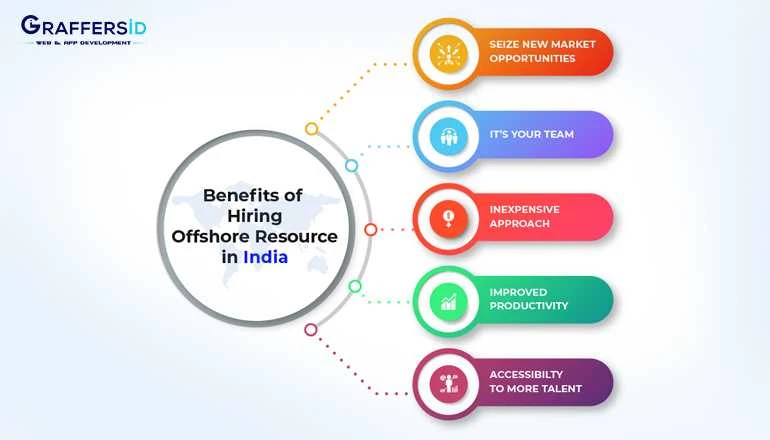Whether it is London, San Francisco, Berlin, New York, or any other major city, hiring a software developer can burn a hole in your pocket. Apart from eye-watering salary, the other expenses will also be associated with rent, pensions, equipment, perks, and taxes. That is the reason why today, business owners are looking to set up an offshore development center to balance the cost of growing their software business.
What the Offshore Development Centre means.
When it comes to the software world, offshoring is where a company hires a brand-new team of developers in another country. They are just like regular employees; the only difference is that instead of working locally with your in-house team, they are based elsewhere.
Here are a few reasons why you should consider establishing offshore software development centers:
1. Operating costs:
Building a software development team or hiring offshore developers in countries like India, Sri Lanka, or Eastern Europe is less expensive than in Paris, London, or New York. Premises, salaries, and equipment are all cheaper because of the affordable cost of living in these regions.

2. Scarcity of Talent:
Highly qualified software engineers are hard to nail down across Western Europe and America. Tech economies in India, such as Bangalore, produce more world-class IT engineers than anywhere else on the planet.
3. Shared Responsibility:
When you outsource a given component, the parties agree on what has to be done, and the impact and risk management are shared among them. Being part of its core business, the offshore development team manages and mitigates the risks produced by the development team in a better way.
Read More: What are the questions that need to be asked before hiring an iOS app developer?
How is this different from Outsourcing?
Outsourcing involves engaging third-party vendors on temporary contracts to deliver software development. These vendors generally employ developers on an ad-hoc basis for sporadic projects.
The problem with outsourcing is that these developers do not work only for you; they cater to different clients and different projects. Since the main driver for outsourcing is cost, companies try to get the work completed at the lowest price possible. The result is always below expectations since the developers do not get incentives to do a good job.
Setting up an offshore development team rather than looking for in-house developers or outsourcing the project, not only gives you access to a wider pool of talent but also offsets the high rates and competition prevalent in the US, the UK, and other Western countries.
However, before you take the leap and recruit your first offshore developers, there are a few things that should be considered. Hiring offshore developers is strenuous and challenging, and that’s why we bring you a few key learning that helps you make the transition from an in-house to an offshore team with ease.
If you are overloaded with software projects and pressing deadlines, it makes more sense to hire an experienced team of developers with a proven track record.
Advantages of ODC (Offshore Development Centre)
This section delves into the multifaceted advantages that ODCs bring to the table, elucidating how this model fosters efficiency, cost-effectiveness, and innovation in the realm of software development.
Cost Efficiency:
One of the primary advantages of ODCs is the significant cost savings they offer. By establishing development centers in regions with lower labor costs, companies can tap into a vast pool of skilled professionals without compromising on quality. This allows organizations to allocate resources more efficiently, redirecting funds towards other critical aspects such as research and development, marketing, or infrastructure improvements.
Access to Global Talent Pool:
ODCs provide unparalleled access to a diverse and highly skilled talent pool. By setting up development centers in different geographical locations, companies can leverage the expertise of professionals from various cultural backgrounds. This not only enhances the quality of the development process but also fosters a culture of innovation and creativity by bringing together individuals with different perspectives and problem-solving approaches.
24/7 Productivity and Agile Development:
The time zone difference between the home office and the offshore development center allows for continuous development and support. This 24/7 work cycle promotes agile development methodologies, enabling faster turnaround times for project completion. Teams can collaborate in real time, ensuring that the development process is not hindered by the constraints of a single time zone.
Risk Mitigation and Business Continuity:
ODCs play a crucial role in risk mitigation by providing a diversified approach to development. In the event of unforeseen circumstances such as natural disasters, political instability, or economic downturns in one region, development activities can seamlessly shift to another location, ensuring business continuity. This strategic distribution of resources minimizes the impact of potential disruptions on project timelines.
Focus on Core Competencies:
Outsourcing non-core activities to an ODC allows organizations to concentrate on their core competencies. By offloading routine and time-consuming development tasks, businesses can channel their internal resources toward strategic initiatives, innovation, and market expansion. This strategic alignment enhances overall organizational efficiency and competitiveness.
Scalability and Flexibility:
ODCs provide a scalable and flexible solution to accommodate the changing needs of a project. Whether a company is experiencing rapid growth or scaling down its operations, an offshore development center allows for easy adjustment of the team size without the complexities associated with hiring or downsizing an in-house team. This scalability enhances the adaptability of organizations to dynamic market conditions.
Challenges of Offshore Development and Solutions
While it offers numerous advantages, such as cost savings and access to specialized skills, it comes with its own set of challenges. Let’s explore the key challenges associated with offshore development and discuss strategies to overcome them.
Communication Barriers:
One of the primary challenges in offshore development is communication. Differences in time zones, languages, and cultural nuances can lead to misunderstandings, delays, and, ultimately, project failure. To overcome this challenge, organizations must establish clear communication channels, leverage collaboration tools, and ensure that teams are proficient in a common language. Regular video conferences and cultural sensitivity training can also foster a more effective cross-cultural communication environment.
Quality Assurance:
Maintaining consistent quality across geographically dispersed teams can be challenging. Different work environments, processes, and standards may lead to variations in the quality of deliverables. Implementing robust quality assurance processes, conducting regular code reviews, and adopting standardized coding practices are essential to ensure that the final product meets the desired quality standards. Automated testing tools can also play a crucial role in identifying and addressing potential issues early in the development process.
Time Zone Differences:
Working across different time zones can be a double-edged sword. While it allows for continuous development and faster project turnaround, it can also result in delays due to asynchronous communication. To mitigate this challenge, organizations can adopt an overlapping work hours model, where teams have a few common working hours to facilitate real-time collaboration. Additionally, leveraging project management tools that provide visibility into team progress and milestones can help synchronize efforts across time zones.
Cultural Misalignment:
Cultural differences can impact team dynamics, leading to misunderstandings and a lack of synergy. To foster a unified team spirit, organizations should invest in team-building activities, encourage cross-cultural awareness, and promote a shared organizational culture. This includes establishing a set of common values and goals that resonate with team members across diverse backgrounds. Regular team meetings, both virtual and in-person when feasible, can help strengthen interpersonal relationships and build trust among team members.
Security Concerns:
Offshore development often involves the exchange of sensitive information across borders, raising concerns about data security. To address this challenge, organizations must implement robust cybersecurity measures, including data encryption, secure communication channels, and strict access controls. Regular security audits and compliance checks ensure that the offshore development process adheres to industry standards and regulatory requirements, mitigating the risk of data breaches.
Common Misconceptions about ODCs
Despite their widespread adoption, ODCs often find themselves surrounded by a cloud of misconceptions. In this section, we will unravel and dispel some of the most common misconceptions about Offshore Development Centers.
Misconception 1: ODCs are Only About Cost Savings
One prevalent misconception about ODCs is that they are solely a cost-cutting measure. While it’s true that outsourcing to ODCs can lead to significant cost savings, focusing solely on this aspect overlooks the broader value proposition. ODCs provide access to specialized skills, diverse perspectives, and a 24/7 development cycle, contributing to enhanced productivity and innovation.
In reality, organizations leverage ODCs not just for financial reasons but also to harness a global talent pool, access domain expertise, and accelerate time-to-market for their products and services.
Misconception 2: Communication Challenges are Inherent
Another misconception revolves around the belief that working across different time zones and cultures inevitably leads to communication challenges. While it’s true that geographical dispersion can present communication hurdles, ODCs have evolved to address these issues effectively.
Modern communication tools, project management platforms, and cultural awareness programs have significantly improved collaboration across borders. Successful ODCs prioritize clear and transparent communication, fostering a collaborative environment that minimizes misunderstandings and ensures project success.
Misconception 3: Quality Suffers in Offshore Development
Some skeptics argue that outsourcing development work to ODCs results in compromised quality. However, this assumption is rooted in outdated perceptions. The reality is that many ODCs adhere to international quality standards and industry best practices.
Established ODCs often implement robust quality assurance processes, comprehensive testing methodologies, and stringent coding standards. Regular audits and continuous improvement initiatives ensure that the delivered solutions meet or exceed the quality expectations of their clients.
Misconception 4: ODCs Lack Innovation and Creativity
Contrary to the belief that ODCs are merely execution hubs without room for innovation, many successful organizations leverage offshore teams to drive creativity and innovation. ODCs are not just about following instructions but actively contributing to problem-solving and product improvement.
Innovation flourishes in ODCs where teams are encouraged to think critically, share ideas, and bring diverse perspectives to the table. Companies that foster a culture of innovation within their ODCs often find that these offshore teams become valuable contributors to the overall strategic direction of the organization.
Read More: How to Overcome the Key Challenges of Offshore Development Centers?
How to Choose the Best Offshore Development Partner:
1. Share your Product Vision:
While hiring an offshore development team, it is always essential to share the bigger picture. Giving them a full product vision and explaining the goals in detail will aid them in planning the work in the right direction from the initial stage.
Paint the picture of your product that you have in your mind so they can make smarter decisions as they work on the project. Moreover, your offshore team needs to understand and be able to determine the upcoming work. Make sure to share all the details with your offshore teams, like sprint planning and the release date of the product.
2. Engage More:
It is crucial to engage more with the development team that is working offshore on your projects. When you are working with a remote team, communication is vital to make sure that they are not left in the dark. It is better to over-communicate to remain updated about what is going on with the business.
Don’t simply engage with them once a week or once a day during scrum meetings. Make sure you are engaging them once every day to get an update on the project and helping them however you can.
3. Overlap the Work Schedule:
One of the biggest challenges that comes with hiring an offshore development team is the vast difference in time zones. India is 9 hours and 30 minutes ahead of the USA. However, web and app development companies in India often have flexible working schedules. You can communicate with the team early in the morning or late at night.
Moreover, the shifted hours work as an advantage, as your offshore team in India can provide on-call support while your USA team is asleep.
4. Keep Communication Simple:
Depending upon the country where your offshore team is located, chances are that they may not be as fluent in your language as you are. The best thing to prevent misapprehension is to keep the communication simple.
Make sure you are using a common vocabulary, avoiding metaphors and cultural references that they won’t understand.
Get straight to the point, state the obvious, and be clear with your directions. If their fluency of the language is not as good as yours, get to the point and don’t make them assume anything.
5. Don’t Micromanage:
Controlling every part can lead to problems on the part of your offshore team. Moreover, it is hard to scale your development team if you can’t trust them with the work that has been allotted to them. Make sure that the offshore team you are hiring has a senior developer who can act as a team lead.
It would be beneficial for both you and your offshore team if your offshore team is self-managing and successful. The team you are hiring must have the right mix of developers, senior developers, and potentially a project manager.
6. Use Images and Quick Video:
Software development is all about communicating your requirements in the right manner. Try to use images, screenshots, and quick videos to explain your requirements.
It will take just a few seconds to take a screenshot of something and doodle on it. With that little doodle, you can make your team instantly understand what you are talking about. It can save hours.
In addition to this, you can also share the video. You can use tools like Vidyard to record some feedback or quick training videos and email it instantly to the team.
7. Treat them as your team:
One of the biggest mistakes that companies make when hiring offshore professionals to make is that they keep the “us versus them” mentality towards their offshore team. Don’t keep your offshore team at arm’s length. To keep a healthy working environment, it is better to treat them like they are part of your team.
Here are a few ways you can make them feel that they are part of your team:
- Avoid the “us vs them” mentality.
- Schedule meetings regularly and even plan for in-person meetings.
- Include them in company and time meetings
- Include them in all communications.
Read More: Benefits of Hiring Dedicated Developers
Why Choose India to Set Up an Offshore Development Team?
Setting up an offshore development team is a crucial business decision, which means the benefit must also be significant and tangible.

Here are two major reasons explained in detail for setting up an offshore development team:
1. Talent:
In a recent study conducted by the Institution of Engineering and Technology, it was found that the shortage of engineers is growing, which negatively affects the business.
The employable developers either lack the necessary skills or are underpaid. India is a country with a rising number of STEM graduates. Since the country emphasizes IT and English education, these engineers are highly capable of filling the American shortfall. Thus, when building a team in a country like India, you will find a 5x larger talent pool.

2. Cost:
Most major software businesses are based in cities, cities are typically expensive, and therefore, rent, wages, and everything else involved in running a business are also expensive.
In India, the cost of living is significantly lower than in the UK or US. The average developer salary in India, even in tech-focused economies like Bangalore, is considerably lower as compared to countries like the UK or the US. When you consider the cost of rent, health insurance, and travel, it’s a huge difference. Thus, building an offshore development team in India can bring a huge benefit to your business.
This was all about offshore development centers. I hope this article has helped you understand all the key points associated with developing a software team in offshore countries.
For more such updates, stay tuned!



